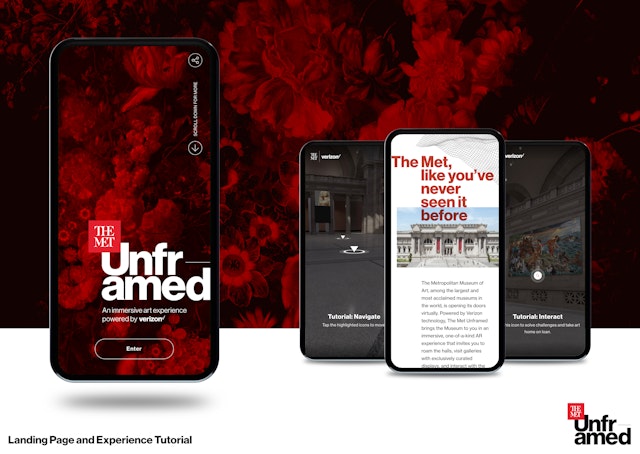Taking visitors on a virtual tour of the New York Met boosted Verizon's brand perception
Unit9 & 140 won the Travel and Tourism, Best Brand Experience, Mobile, and Brand Collaboration or Partnership categories at The Drum Awards for Marketing 2021. Read about their ‘Met Unframed’ campaign for Verizon which snagged four awards thanks to its inspired concept and superior technical execution.
The challenge
Due to Covid-19, The Metropolitan Museum of Art in New York City had to close its doors to the public for the first time in over 100 years. At the same time, Verizon was rolling out their 5G network, a transformative technology. But unless you’ve tried 5G yourself, it’s tough to get a sense of how ground-breaking it really is.
The Met’s mission is to connect people to creativity, knowledge, and ideas. Verizon’s goal is to show the power of their 5G network, something that was admittedly difficult at a time when most of the world was stuck indoors, connected to WiFi. Together, the two companies had an opportunity to use the power of 5G to make The Met’s art accessible for anyone, anywhere.
The key objectives were:
-
Get as many people as possible to connect to The Met’s artwork virtually.
-
Demonstrate Verizon 5G network superiority messaging in a very cluttered landscape.
-
Drive Preference for Verizon.
-
Cement Verizon’s position as a leader in innovation.
The strategy
The longer lockdown lasts, the more divorced from culture people have become. Sports, live music, and actually being with friends - these basic pastimes became inaccessible to everyday people. Many brands jumped in to try to bring events online as quickly as possible. But these livestreams couldn’t replace the feeling of being there. A livestream doesn’t replace a live concert.
Together, Verizon and The Met developed and curated 13 never-before-seen galleries and 46 immersive art challenges. And for the first time in history, it gave visitors the ability to take Met art home on loan, powered by AR.

The campaign
It started with a detailed 30,000 sq. ft 3D render of The Met. WebAR and WebGL technology gave visitors a true sense of both the scale, as well as the intricate detail of the artworks. The virtual walkthrough matched the deliberate nature of an in-person experience. Visitors were encouraged to enable their gyroscopes, giving them a natural way to immerse themselves in the 360-degree environment. Every detail of the experience was inluded, from the marble floors to the expansive skylights overhead.
Second, to make a connection between visitors and the artworks, the team created a variety of ’unlocking challenges’. These were essentially guided examinations that gave new entry points, new tools, and a new framework to engage with the work. These were designed with both novices, who had never been to The Met or taken an art history class, as well as longtime Met visitors in mind, letting them get way closer to the art than any docent would previously have allowed.
The final task was to make the world-famous art not only more accessible but also more personal. To ensure The Met Unframed could be experienced by as many people as possible, it was built to work on standard platforms like WebGL and WebAR that are already integrated into most smartphones. This meant there was no need to download an app - users from all over the world could access the immersive experience by simply visiting a URL on their mobile device.
AR functionality was built in to let people ’take’ art off The Met’s virtual walls and bring it into their homes for a spell. This created some exclusivity - just like in the real world, only one copy of each work was available for loan at a time.
And, of course, it was easy to share on social - because who wouldn’t want to show off a Met masterpiece like Washington Crossing the Delaware in their living room?
The results
The experience garnered over 1bn impressions (over 93% earned media), averaging 20,000 visits per day from over 153 countries during the five-week campaign - more than The Met would get pre-pandemic.
The campaign generated over 40 original articles in publications ranging from CNN and The Washington Post to tech publications like CNET to art publications like Artnet.
Verizon needed to demonstrate their 5G superiority for consumers who were stuck indoors at a time when the highest bandwidth 5G was mostly outdoors. This meant building exclusive experiences for customers who already had 5G devices, and included branding and messaging on intertitles and load screens for visitors on 4G or Wi-Fi.
People who visited The Met Unframed were 2.4x more likely than the general public to report that Verizon is a leader in 5G, 2.2x more likely to say Verizon has the fastest 5G network, and 2.3x more likely to report that Verizon has the best 5G coverage.
Verizon’s brand affinity was 85% for Met Unframed visitors, 2.6x higher than for unexposed. 92% of respondents said they would recommend The Met Unframed, powered by Verizon, to a friend. And 60% of respondents (both current customers and prospects) reported that the experience improved their perception of Verizon as a company that enables them to do new things.
76% of respondents who visited The Met Unframed said that “Verizon innovates in ways that make my life better,” a 2.3x increase over the general public. 59% said that the experience improved their perception of Verizon as a company that builds what's next. And 56% reported that The Met Unframed improved their perception of Verizon’s impact on society.
All in all, the campaign reopened one of the world’s most important art collections, got more visits during the five-week campaign than the actual Met would average pre-pandemic, and drove significant perception changes for Verizon.
This project was a winner at The Drum Awards for Marketing 2021. Find out which competitions in The Drum Awards are currently open and don’t forget to visit our new interactive calendar.
Content created with:

Verizon
Find out more
